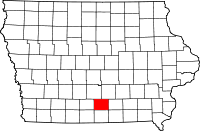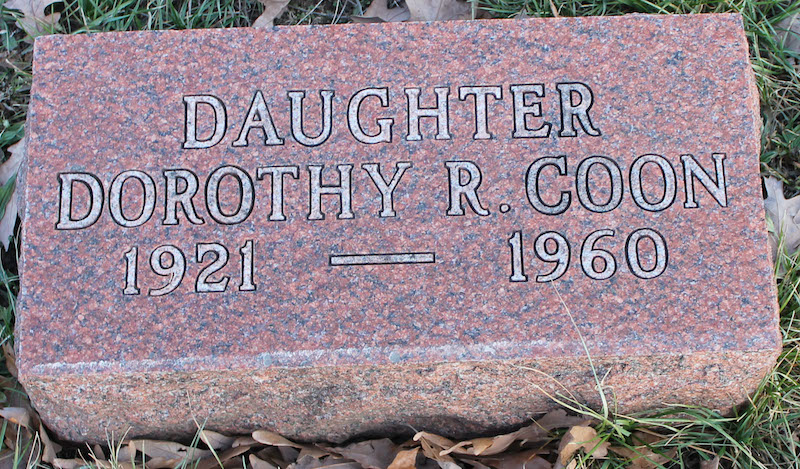
Dorothy Coon
Dorothy Ruth Coon
Homicide
Dorothy Ruth Coon
38 YOA
2017 61st St., Des Moines, IA
Body found in rural Chariton, IA
Lucas County
Investigating Agency: Des Moines Police Department
Case # 1960-10204
DCI Case # 60-07871
Disappeared: August 26, 1960
Body Found: August 29, 1960
On Monday evening, August 29, 1960, Dorothy Coon was found dead in a ditch alongside a county road in Lucas County, Iowa, about 12 miles north of Chariton. Her body — clad in a dark green dress and white shoes — was discovered by a farmer mowing weeds. Her purse was found one mile away.
The gravel road was a shortcut to Coon’s parents’ farm east of Chariton, and in the vicinity of Albia, Iowa.
 Lucas County in Iowa
Lucas County in Iowa
 Chariton in Lucas County
Chariton in Lucas County
In a Mason City Globe Gazette article dated August 30, 1960, Lucas County Sheriff Wayne Swanson said Mrs. Coon had been dead two or three days.
Coons, a department store business office clerk and divorced mother of two teenaged children, Nancy, 19, and Dennis 17, had disappeared on Friday night, August 26.
Heavy rains over the weekend may have washed away or covered up footprints, tire tracks or other clues involving in her slaying, Swanson said in a Cedar Rapids Gazette story published August 31, 1960.
Officials conducted a careful search of weeds and bushes along a mile of roadside ditches near where Coon’s body was found, but the search failed to provide any significant clues to her murder.
Preliminary reports showed no wounds on Coon’s body, but authorities noted there were bruises on the throat area and fractured neck bones indicating she may have been strangled.
Ex-husband still in victim’s life
Coon and her ex-husband, Richard Coon, had divorced 10 years earlier after Richard left Dorothy Coon for a widow living across the street from the Coons. Richard Coon — the manager of a glove manufacturing company in financial straits — would not pay child support or alimony, but continued to occasionally meet up with his ex-wife in Des Moines.
Richard eventually married the widow, and he and his new wife relocated to Albia the year before Dorothy Coon’s murder.
Richard Coon was questioned in his ex-wife’s murder, but said he was home that evening with his new wife and her son. Polygraph test results were inconclusive.
The Coon’s children were living with Dorothy at the time of her murder but were asleep when she left the house late on Friday night.
“There is no question that this is a murder,” Tillman Thompson, chief of the state Bureau of Criminal Investigation, said in the Aug. 31 Gazette article. Thompson declined to comment on possible motives.
Though Coon’s body was discovered in Lucas County, her name was included in a July 10, 2009 list of Des Moines unsolved homicides sent to Iowa Cold Cases by the Des Moines Police Department.
When the Iowa Division of Criminal Investigation (DCI) established a Cold Case Unit in 2009, Dorothy Coon’s murder was also one of approximately 150 cases listed on the Cold Case Unit’s new website as those the DCI hoped to solve using latest advancements in DNA technology.
Although federal grant funding for the DCI Cold Case Unit was exhausted in December 2011, the DCI continues to assign agents to investigate cold cases as new leads develop or as technological advances allow for additional forensic testing of original evidence.
The DCI remains committed to resolving Iowa’s cold cases and will continue to work diligently with local law enforcement partners to bring the perpetrators of these crimes to justice for the victims and their families.
 Courtesy photo Bethalene, findagrave.com
Courtesy photo Bethalene, findagrave.comDorothy Coon is buried in Gosport Cemetery in Marion County.
About Dorothy Coon
Dorothy R. (Chamberlain) Coon was born in 1921, the daughter of Charles William and Leota Blanche Chamberlain. In addition to her parents and two children, she was survived by a brother, Billy V. Chamberlain.
She was preceded in death by a sister, Mary Eloise Chamberlain.
Dorothy Coon was buried in Gosport Cemetery in Gosport, Marion County.
Information Needed
Anyone with information about Dorothy Coon’s unsolved murder is asked to contact the Iowa Division of Criminal Investigation at (515) 725-6010, email dciinfo@dps.state.ia.us, or contact the Des Moines Police Department Detective Bureau at (515) 283-4864.
Sources:
- Iowa Division of Criminal Investigation, former Cold Case Unit
- “‘Gone Cold’: Dorothy Coon,” The Northwest Iowa Review, Part of the Gone Cold series, Wednesday, June 8, 2016
- “Gone Cold: Dorothy Coon, killed in 1960,” Special to the Register, The Des Moines Register, Part of the GONE COLD: EXPLORING IOWA’S UNSOLVED MURDERS series, Saturday, January 30, 2016
- Des Moines Police Department, correspondence to Iowa Cold Cases, July 10, 2009
- Dorothy R Chamberlain Coon (1921 – 1960) – Find A Grave Memorial
- Person Details for Dorothy R Chamberlain in household of Charles Chamberlain, “United States Census, 1940” — FamilySearch.org
- “Unsolved Iowa killings: friends ‘still feel scars’,” by Nick Lamberto, The Des Moines Register, Sunday, September 8, 1974
- “List of ‘case open’ slayings in Iowa,” by Nick Lamberto, The Des Moines Register, Sunday, September 8, 1974
- “The Growing List of Iowa’s Unsolved Murder Cases,” by Nick Lamberto, The Des Moines Register, November 24, 1968
- “Clues Scarce in Slaying of D.M. Divorcee,” The Cedar Rapids Gazette, August 31, 1960
- “Probe death of Iowan,” The Mason City Globe Gazette, August 30, 1960
Copyright © 2024 Iowa Cold Cases, Inc. All rights reserved. This material may not be published, broadcast, rewritten or redistributed.



 Chariton in Lucas County
Chariton in Lucas County Courtesy photo Bethalene, findagrave.com
Courtesy photo Bethalene, findagrave.com
The Chief of the state Bureau of Criminal Investigation, Tillman Thompson said, “There is no question that this is a murder” in an article published in the Gazette. If that is a correct statement, why does the death certificate indicate the cause of death as “unknown”. Why or how could there be such a discrepancy?
Andrea, at the time, whoever conducted the autopsy most likely could not determine a cause of death, with the medical knowledge and the available forensic tools available, at the time
I am of the mindset that the autopsy results should be reviewed by more experienced medical examiners. Then if necessary, they could recommend that her remains be exhumed, for review by them and a forensic anthropologist. Hopefully, they could determine an exact cause of death.
However, in the minds of law enforcement her death most likely was caused by someone. Since the autopsy states her cause of death is undetermined, they can’t close it out, one way or the other.
I’m not sure what the autopsy report says only the death certificate. It was a doctor that signed it. It’s odd to me that detectives are saying there’s no question and the death certificate says cause of death unknown. It would be interesting to see the autopsy report.
One would think if there’s obvious neck bruising and fractures , there would be more information than cause of death unknown. Wish there was more information available about the state of her body when she was found.
I feel terrible for those who’ve wondered all these years what happened to their loved one.
Andrea, the other issue is that at the time, most communities had a coroner. A good number of these individuals most likely were undertakers and not certified medical examiners.
Again this makes me to think it would be a good idea to have a team of medical examiners to review all these cases where the cause of death going bacK 40 or more years are undetermined.
This would help law enforcement to decide whether her and many others deaths were homicides or a non-criminal deaths.
We have teams of cold case detectives reviewing cold cases. We should have teams of medical examiners to review these cases.
What’s interesting is the Smithsonian Institute in Washington has forensic anthropologist who have been reviewing bodies at the request of many agencies for many years.
Quite often they have found marks and other indications that a person was murdered.
Also, the initial investigators most likely did not have the training that a homicide investigator in many of are major cities did.
I remember two major crimes here in Chicago back in the late 1920’s. The first one was the kidnapping and murder of Bobby Franks. He was the son of a wealthy family in Chicago.
He was found dead in a rail yard on the far southeast side of Chicago, on the Indiana border. At the crime scene Chicago Police Department detectives found a pair of eyeglasses.
The eyeglasses were made by a well known company of Almer & Coe. The detectives got lucky with these glasses, they were a newer model frames. Also only three people had glasses with those frames.
It led to one of two wealthy college educated men. They were arrested and charged with murder. They were defended by Clarence Darrow, who pled them guilty to avoid the death penalty.
The other is the St. Valentines Day Massacre. A Cook County Coroners Jury was impaled. Two wealthy members of the jury brought in a Dr. Goddard. He was a U.S. Army Reserve doctor. But he worked.st a private crime lab.
He reviewed the crime scene of murder of Bugs Moran gang. He said that two Thompson submachine guns were used. One of them had a twenty round straight magazine, and the other with a fifty round drum magazine.
Dr. Goddard is considered the sort Father of Ballistics.
However we now have scientists reviewing the science behind many things that were considered a slam dunk over many years.
Any news on this case??? This is my grandma.
Sherrie – I don’t have news for you. I just wanted to say I am truly sorry for you and your family.
Geez!! I never knew Iowa had so many cold cases!! Prayers to the family, and hope we can crack some of these cold cases!!!!
I agree. It is a harsh reality to wrap your head around.
Ex-husband….